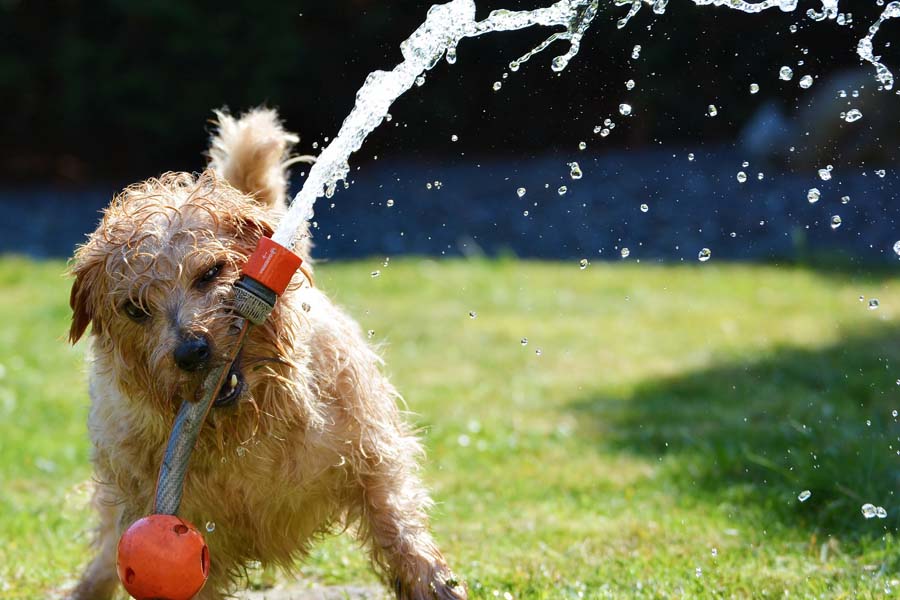A Turramurra Pet Care Article
How Hot is Too Hot? Dangers of Heat Stress in Pets

How Hot is Too Hot? The Dangers of Heat Stress in your Pet
by Dr Gretta Howard, Senior Veterinarian
Pets are at a higher risk of heat stress compared with people due to their fur coat, higher core body temperature compared with humans and the way they use their bodies to cool down.
What is heat stress?
Heat stress, also known as heat stroke or heat exhaustion, is where the body overheats to a dangerous level, and this can be life-threatening.
During summer, the risk for dogs overheating during exercise or being left in cars is much higher, due to the high outside temperature, which interferes with their body’s ability to keep cool.
A normal dog’s temperature is usually between 38 – 39°C and they have a fur coat on all year round. If the dog’s temperature reaches 41°C or higher, then a true emergency exists. Once their body temperature gets to 43°C, critical organ failure can occur.
Brachycephalic breeds (flat-faced breeds) have a much higher incidence of overheating as their airways are not as effective in oxygen delivery and cooling down, so it’s important to be particularly careful with flat-faced breeds on hot days.
One of the main ways a dog cools down is through panting, which produces a higher air flow over the moist surfaces in the upper airways, resulting in evaporative cooling.
Guinea pigs are often kept in outdoor enclosures, but during the Australian summer, temperatures commonly get above 24°C, which can cause dangerous overheating and heat stroke in this species. The ideal temperature for this species is between 15-24°C so owners should monitor temperature carefully to avoid putting them at risk of heat stroke.
Heat exhaustion can lead to organ failure if treatment is left too late unfortunately. If you suspect your pet has developed heat stress, do not delay and take your pet to a vet immediately for emergency care.
Top 10 tips to keep pets cool in summer
Don’t leave your pet in the car. The temperature inside a car can get to 20 degrees higher than the outside temperature within just 10 minutes! After an hour, cars are 40 degrees higher than the outdoor temperature. So, if it’s 35°C outside, your car’s temperature could get to 75°C! That’s hotter than any outside temperature ever recorded! So, as with children, never leave pets unattended inside a parked car in the summer. It’s not worth the risk!
Exercise your dog in early morning or evening. Choose either early morning or late evening to exercise your dog, as sometimes even they don’t know when enough is enough.
Make sure there is plenty of drinking water. Always provide multiple water bowls so that if your pet needs more water to cope with hot weather or accidentally knocks one of them over, water is always available.
Do not tether your dog outside. It’s important that dogs can move around freely in their backyard to find areas that are cool and to ensure they can access water all day. In the backyard, shady areas change throughout the day, so tethering means that your dog could be positioned in the direct sunlight, or worse still, there is a risk of strangulation if your dog’s leash gets caught around the neck.
Never use a tight-fitting muzzle during exercise. Some dogs are required by law to wear a muzzle to be walked outside, but this should be a basket style of muzzle so that the dog can pant while wearing a muzzle. A tight-fitting muzzle can lead to heat stress because your dog pant and overheats.
Provide a wading pool for your dog. Most dogs love a dip in the water on a hot day. Pools can be unsafe for dogs as they may not know how to get out, but an alternative option is a plastic wading pool with a shallow amount of water that your dog can get in to cool off. If your family has toddlers or small children, these are not recommended as they are unsafe.
Keep your pet at a healthy weight. Overweight dogs are in a high risk category for heat stress, so at the next health check, remember to ask your vet how to safely put your pet on a diet.
Keep your pet indoors if hot outside. If the temperature outside reaches 35°C plus outside, then it is safer to bring your dog indoors in a well-ventilated area, preferably with air-conditioning, to keep cool. Brachycephalic breeds, on the other hand, should not be left in temperatures over 30°C due to their pre-existing breathing issues. Smaller mammals, such as rabbits and guinea pigs, should not be left outdoors if the temperature is over 24°C.
Make sure your dog has a shady spot in the backyard. Like people, dogs seek shelter from the sun during the heat. If there is insufficient shade in your backyard, then you may need to rethink leaving your dog outside.
Ensure garage is kept cool. It may not be safe to keep your pet in your garage during a hot summer’s day. It’s vital to monitor the temperature inside your garage on a hot day, before deciding if it is safe inside. Consider installing garage insulation or air-conditioning within that space.
Summer is a time to really enjoy your pet’s company, so hopefully remember to have fun in the sun but keep a look out for heat stress too!


